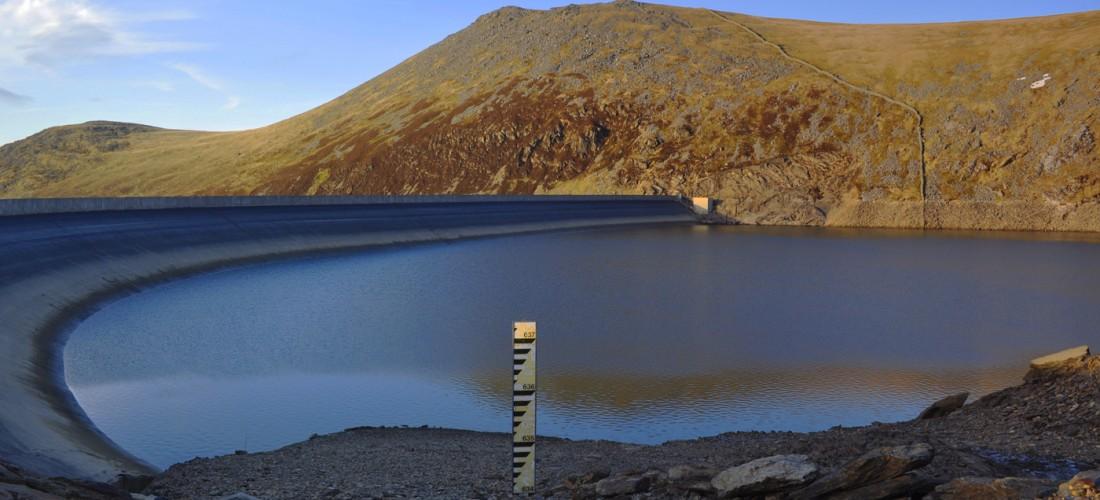 Marchlyn Mawr reservoir is a high level lake in Snowdonia behind Elidir Fawr mountain. It is used as the high level water source for Dinorwig power station, a closed-loop pumped storage hydroelectric generating facility. (Credit: Flickr @ Hefin Owen http://www.flickr.com/photos/47515486@N05/)
Marchlyn Mawr reservoir is a high level lake in Snowdonia behind Elidir Fawr mountain. It is used as the high level water source for Dinorwig power station, a closed-loop pumped storage hydroelectric generating facility. (Credit: Flickr @ Hefin Owen http://www.flickr.com/photos/47515486@N05/)The question of storing surplus electrical power during the times when its production exceeds its consumption was always essential to ensure the efficient and economical operation of the power generation facilities. However, the power output of the fuel-based power plants (i.e. coal, natural gas or oil) can be adjusted with relative ease. Now, when more and more renewable energy sources are being connected to the electrical grid, our ability to store energy efficiently and reliably becomes truly crucial. While pumped-storage hydroelectricity remains the undisputed leader in the field, a number of new energy storage technologies is also being developed.
Energy derived from photovoltaic and wind sources is variable by nature—the amount of electricity generated by a solar plant depends on the availability of sunlight, and the wind plants are useless when there is no wind. A conventional way of load-balancing (ensuring that you have power when you need it and not only when there are appropriate weather conditions) is through pumped-storage hydroelectricity. With this method the surplus electrical power is used to pump water from a lower elevation reservoir to a higher elevation. When the need for the stored energy arises, the stored water is released through turbines to produce electric power.
Pumped-storage hydroelectricity accounts for more than 99% of bulk storage capacity worldwide: around 127,000MW, according to the Electric Power Research Institute (EPRI). This figure can be significantly increased. In a recent report called “Assessment of the European potential for pumped hydropower energy storage” researchers from the Joint Research Centre—a Directorate-General of the European Commission that provides independent scientific and technical advice to support a wide range of EU policies—say that Europe’s pumped hydropower storage can be increased tenfold, or even more, from current 2.5 TW·h up to 54 TW·h. Of course, this number is calculated for ideal conditions and will be reduced by the application of environmental and other restrictions, but the potential for pumped-storage hydroelectricity remains very significant.
Several other energy storage technologies are based on a rather obvious idea of using batteries. While battery storage was used since the early days of direct current electric power, the batteries were expensive, had limited lifespans and were hard to maintain. Nowadays scientists are working on modern battery technologies that would be cheap, practical and efficient.
One such technology was recently proposed in a paper published in Energy & Environmental Science (March 2013). Researchers from the U.S. Department of Energy’s (DOE) SLAC National Accelerator Laboratory and Stanford University have developed a membrane-free lithium/polysulfide semi-liquid battery that can be used to mitigate power fluctuations from solar and wind energy plants. According to the lead author of the study, this battery “may be the best yet designed to regulate the natural fluctuations of these alternative energies.” In initial lab tests, the new battery retained excellent energy-storage performance through more than 2,000 charges and discharges, equivalent to more than 5.5 years of daily cycles, and the utility version of this design can be scaled up to store many megawatt-hours of energy.
While this technology is still to be commercialized, utility companies are already using batteries to mitigate possible blackouts. For example, a gigantic 5MW lithium-ion battery was deployed last month at the Salem Smart Power Center in South Salem, Oregon, as a part of Pacific Northwest Smart Grid Demonstration Project. The battery is part of a highly reliable, localized power zone called a microgrid that will enable about 500 southeast Salem customers to tap into a power reserve during electricity disruptions. One of the goals of the project is to ensure successful integration of the various renewable energy sources into the power grid.
A method identified by the researchers at the Department of Energy’s Pacific Northwest National Laboratory and Bonneville Power Administration stands out among the less traditional approaches to the energy storage. As it turns out, it is possible to store surplus energy in porous rocks using compressed air energy storage plants. When power is abundant, it’s drawn from the electric grid and used to power a large air compressor, which pushes pressurized air into an underground geologic storage structure. Later, when power demand is high, the stored air is released back up to the surface, where it is heated and rushes through turbines to generate electricity. Compressed air energy storage plants can re-generate as much as 80 percent of the electricity they take in.
As it can be seen, several electrical grid energy storage technologies already exist, and more are under development. The application of this technologies as the elements of a smart grid would allow to make it more efficient and successfully integrate renewable energy sources to the power system.
Yang, Y., Zheng, G., & Cui, Y. (2013). A membrane-free lithium/polysulfide semi-liquid battery for large-scale energy storage Energy & Environmental Science, 6 (5) DOI: 10.1039/C3EE00072A
